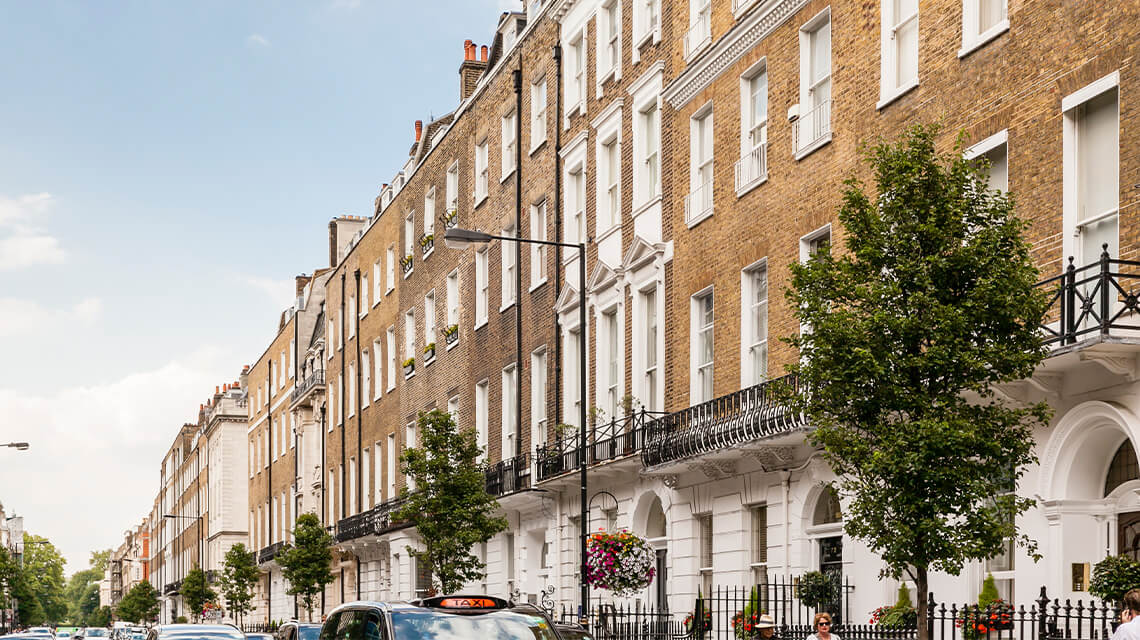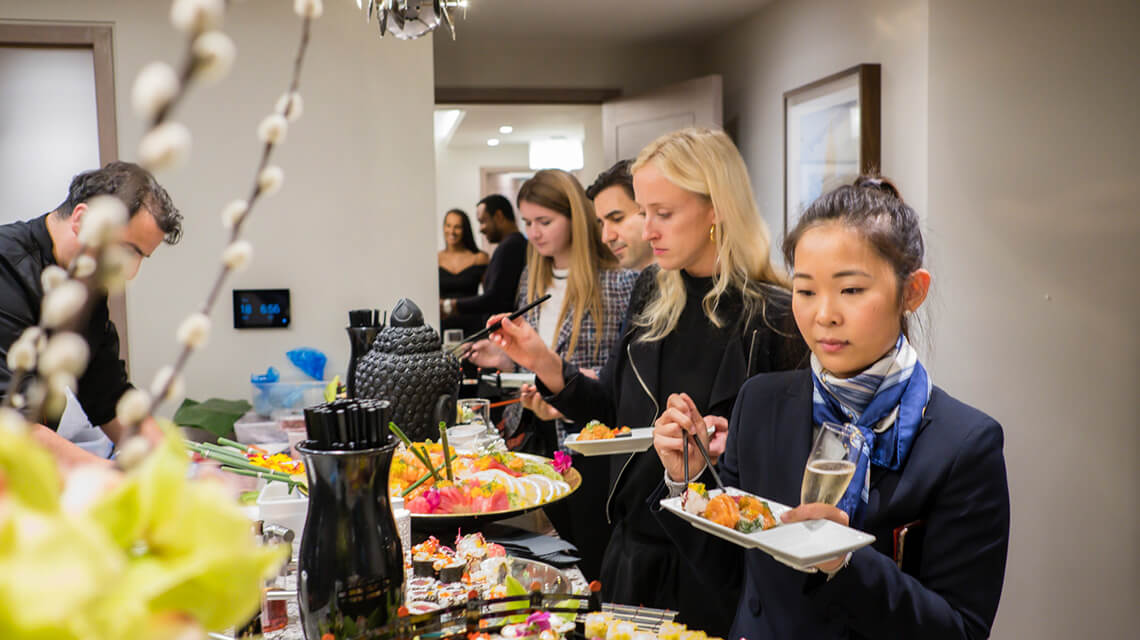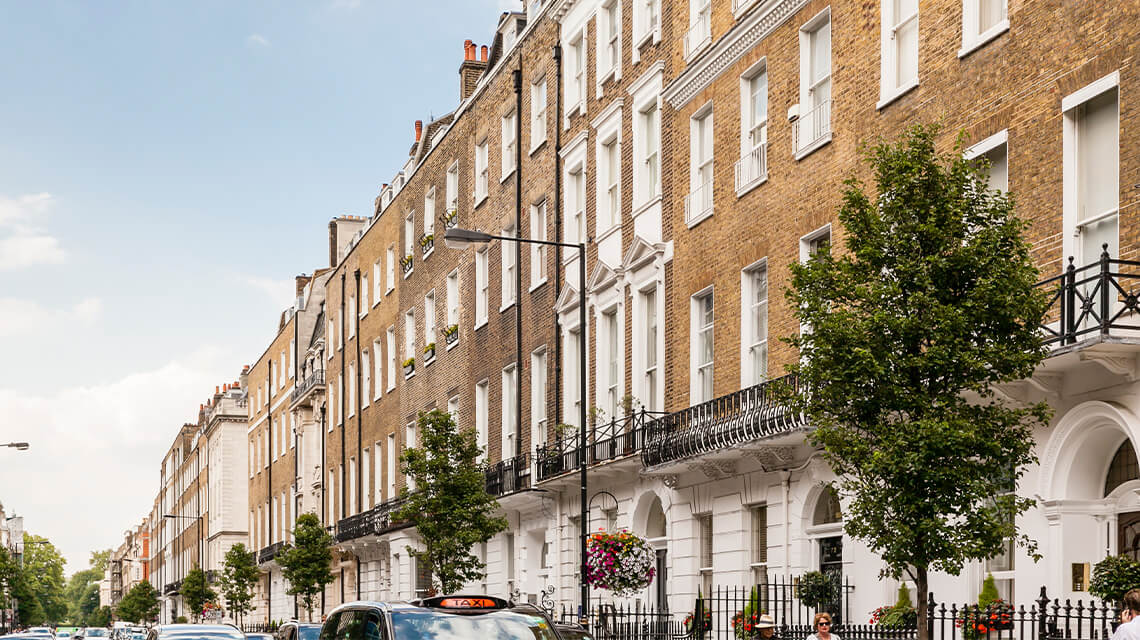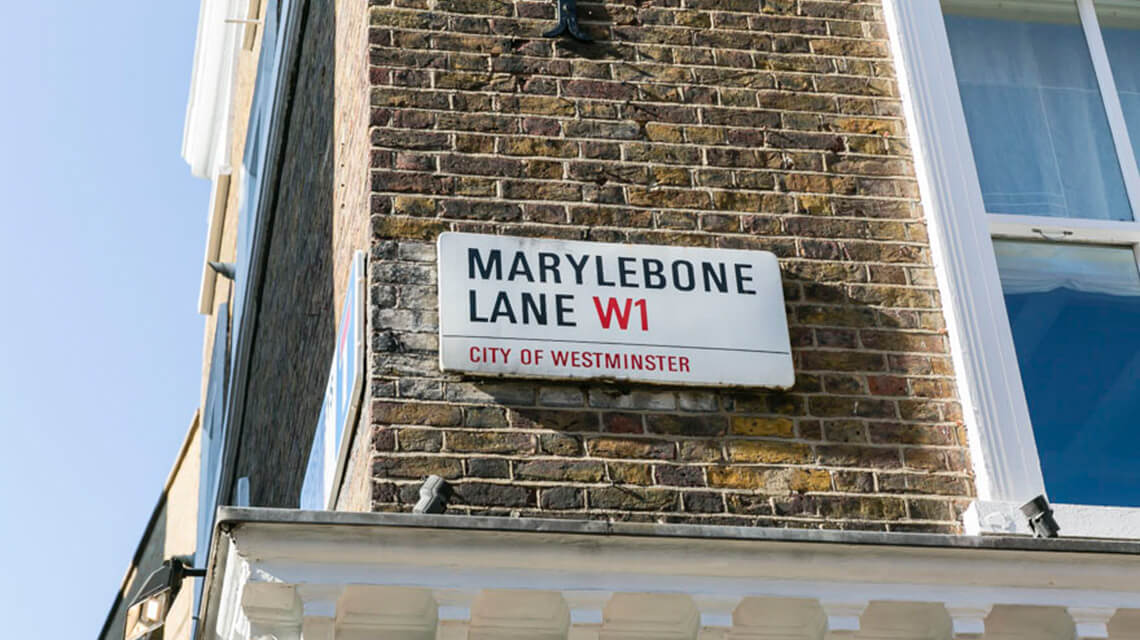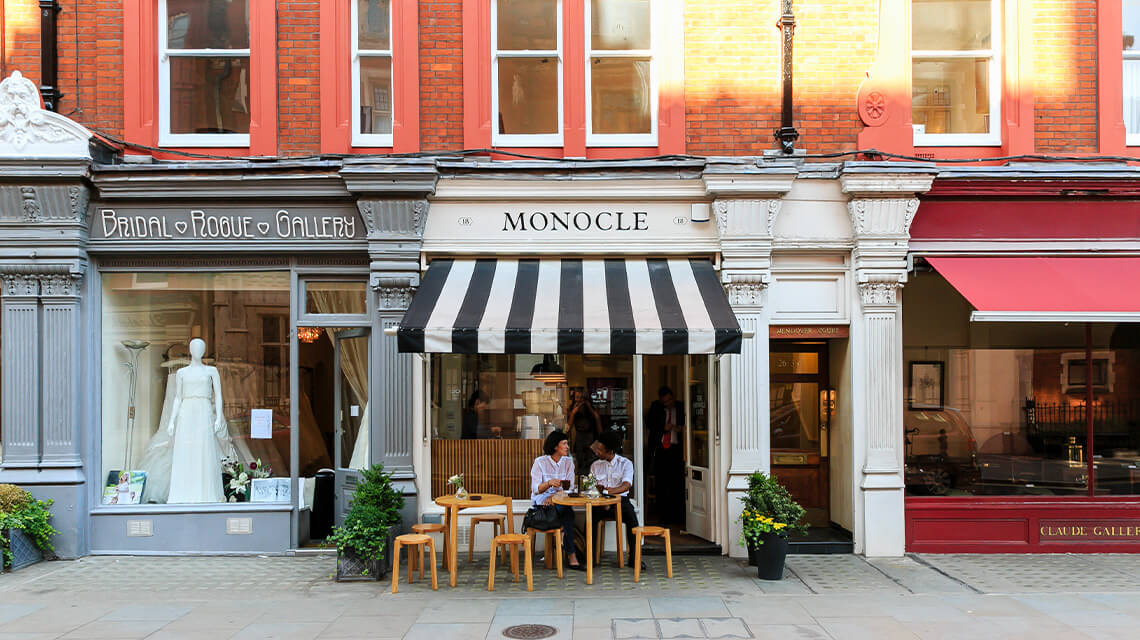Distinguished by striking architecture and attractive garden squares, Marylebone is a majestic pocket of Central London with an interesting history abundant with Royal connections.
It only takes a short walk through this charming neighbourhood to appreciate the variety of eras that have graced the locale. Set around a grid of roads filled with an elegant mixture of Georgian terraces, Victorian mansion blocks and Art Deco-style architecture, many of the building and street names derive from their noble patronage.
Marylebone can trace its beginnings as far back as the Norman Conquest, with historians believing that it originally consisted of two manors, Tyburn to the east and Lilestone to the west with the latter later becoming known as Lisson Grove. Today Marylebone is owned by two major estates The Howard de Walden Estate (92 acres to the east of Baker Street) and the Portman Estate (110 acres to the west).
Follow our timeline of significant events in Marylebone’s history to discover this West End district’s fascinating transformation from rural marshland into a cosmopolitan urban oasis.
Timeline
Medieval Origins
1086 - The Doomsday Book makes reference to the manor of Tyburn, owned by Robert de Vere under the convent of Barking. Tyburn is recorded as having a value of 52 shillings and a population of no more than 50 people.
1196 - Tyburn became the principal place for public execution of London criminals. The first recorded execution took place in 1196 although it is thought that Tyburn acted as a site for execution since 1108.
1400 - A church was built in Tyburn on the bank of a small stream. The Medieval church was dedicated to St Mary the Virgin and consequently the area which the site stands on became known as St Mary-la-Bourne translated as St Mary by-the-stream. Over time the location became shortened to its present form, Marylebone.
Tudor Country Village
1532 - Sir William Portman of Somerset took out a lease for 270 acres of land which incorporated the manor of Lilestone and 11 Tyburn fields.
1544 - Henry VIII acquired the northern half of Tyburn Estate and commandeered Tyburn’s manor house as his hunting lodge, creating a deer park conveniently nearby. The fields and woods where he hunted are now known as Regent’s Park.
1547 - Henry VIII died and his heirs leased the Tyburn manor to a succession of royal acquaintances over the forthcoming years.
1555 - After becoming Lord Chief Justice of England, Sir William Portman purchased the freehold of the leased land, now known in Marylebone as the Portman Estate.
1611 - After many years of leasing the manor, King James sold the Tyburn Estate for £829 to Edward Forest, one of the persecutors of Guy Fawkes.
Georgian Urbanisation
1708 - The Tyburn estate was sold for £17,500 to John Holles, the Duke of Newcastle and later passed to his daughter Henrietta Cavendish Holles.
1713 -Henrietta Cavendish Holles married Edward Harley, 2nd Earl of Oxford, and that part of the Tyburn Estate became known as the Harley-Cavendish Estate.
1715 - Recognising a need for residential housing north of Oxford Street, Lady Henrietta Cavendish Holles and her husband Edward Harley commissioned John Prince to lay plans to convert Marylebone’s rural estate into a grid of fashionable tree-lined streets including Harley Street, with Cavendish Square as its focal point.
1731 - Marylebone Burying Ground began being used as a cemetery until 1857. The site is now Paddington Street Gardens.
1738 - By this time Marylebone had become a popular location for gentry to visit. The landlord of the Rose of Normandy pub to the east of the high street set up the ‘pleasure gardens’ charging admission for visitors to enjoy the surroundings and listen to specially commissioned music.
1741 - After marrying William Bentinck, 2nd Duke of Portland in 1734, Margaret Cavendish Harley, the only daughter of Henrietta Cavendish and Edward Harley, inherited the Harley-Cavendish Estate and it became known as the Portland Estate.
1755 - Henry William Berkeley Portman, the distant heir of Sir William Portman of Somerset, began to develop the London Portman Estate. He began issuing the first building leases including one to William Baker who laid Baker Street.
1756 - Marylebone Road was laid as ‘New Road’ providing a direct route to the City, bypassing Oxford Street. Originally developed as a cattle route, the road became pivotal in Marylebone’s urbanisation as it made the land further attractive for development.
1775 - The Cleveland Street Workhouse opened on an old burial site which was donated by the Portland Estate. Under the Old Poor Law, the building was commissioned for the care of the sick and the poor.
1820 - By this date the development of the Portman Estate was largely complete.
Victorian Growth and Development
1860 - Doctors began to set up practices on Harley Street growing from around 20 consulting rooms in 1860 to 80 by 1990.
1870 - The West London Synagogue opened on upper Berkley Street. Designed by Davis and Emanuel, in a Byzantine/Romanesque style, the building features a pedimented arched entrance in Portland stone and is regarded one of the finest Victorian Synagogues in the country.
1872 - Manchester Square was remodelled by Richard Wallace and later renamed Hertford House. Exhibiting the ‘Wallace Collection’ the gallery contains artistic works by Rembrandt, Rubens, Reynolds, Gainsborough and Delacroix.
1879 - The Portland Estate became the Howard de Walden Estate following the death of the childless fifth Duke which saw the land passed to his sister, widow of the 6th Baron Howard de Walden, Lucy Joan Bentinck.
1889 - The Manchester Square Fire Station opened on Chiltern Street, one of London’s first fire stations. This brought a whole new purpose to Chiltern Street which was originally designed as a service street between Baker Street and Manchester Street.
1890 - Mansion Blocks became popular as a result of the population boom during the Industrial Revolution.
1899 - Marylebone Station opened becoming the Central London terminus for Chilterns Railways.
Early 20th Century Influences
1901 - Wigmore Hall (originally named Bechstein Hall) was launched on 31st May opening to a gala concert starring famous Italian, Belgian and Ukrainian musicians. Built by British architects Thomas Collcutt in Renaissance style, the Hall was designed to look grandly impressive yet appear intimate enough for recitals.
1912 - The Royal Society of Medicine moved to Wimpole Street.
1914 - 1945 - The devastating consequences and aftermath of WW1 and WW2 slowed development and progress in London and Marylebone for 30 years.
1932 - The BBC opened their Broadcasting House on Portland Place and Langham Place within an Art Deco-style Grade II listed Portland stone building. It was from this building that the nation heard the first Christmas speech from a monarch, King George V.
1946 - After extensive bomb damage during the Second World War the Abercrombie Plan for the Rebuilding of London was created. Bryanston Square, Great Cumberland Place and Marylebone Station were particularly damaged and during the 1950s Marylebone High Street underwent significant renovations to its road and shops.
1948 - National Health Service established and around 1,500 doctors existed on Harley Street
1957 - The Western Marble Arch Synagogue opened on Great Cumberland Place, formally known as The Marble Arch Synagogue. Today the synagogue houses one of the oldest congregations in the country.
1960 - Polytechnic of Central London (PCL) opened a new site on Marylebone Road for architecture and building technologies as well as an engineering and science centre on New Cavendish Street.
1965 - Marylebone joined with Westminster and Paddington to create the City of Westminster having previously belonged to the Borough of St Marylebone in the County of London.
1967 - The Beatles Apple shop at 94 Baker Street opened but closed months later.
1968 - Britain’s first heart transplant was successfully carried out at the National Heart Hospital, Marylebone.
Late 20th Century Rejuvenation
1990 - The Wallace Collection opened to the public as a museum on 22nd June.
1992 - Polytechnic of Central London was granted University status becoming the University of Westminster.
1995 - One third of all shops on Marylebone High Street were vacant urging Howard de Walden Estate to implement a strategy to rejuvenate Marylebone. Properties were refurbished, lease agreements were renegotiated, and the Estate began sourcing upmarket businesses and retailers to move into the area, selecting candidates on the merit of the quality they would bring to the area instead of the rent they would pay. Howard de Walden coined the term ‘Marylebone Village’ as part of their marketing strategy.
1997 - Queen Elizabeth II unveiled the Wallenberg Statue in a ceremony attended by the President of Israel and the Secretary General of the United Nations. Commemorating Raoul Wallenberg, the Swedish saviour of thousands of Jews from Nazi death camps, the monument stands outside Western March Arch Synagogue on Great Cumberland Place. The unveiling was a tremendous occasion and the first time the Queen had ever entered a synagogue.
1998 - Fashionable furniture designers Conran opened up shop on Marylebone High Street after the Howard de Walden Estate granted the lease of a derelict former tyre depot. The opening attracted visitors to the quieter, northern end of the high street.
1999 - Waitrose opened its doors in Marylebone despite higher offers from Sainsbury’s and Tesco following the Howard de Walden’s regeneration strategy.
Today’s Marylebone Village
2002 - Marylebone High Street was voted London’s best street in a Radio 4 poll who described the high street as ‘a haven in the middle of a frantic city.’
2003 - Marylebone Farmers’ Market - London’s largest farmers’ market - opened and has been running every Sunday for over 10 years making a significant contribution to Marylebone’s Sunday pedestrian footfall.
2008 - Marylebone joined the likes of Mayfair, Belgravia and Kensington in the ‘Prime Central London’ league.
2013 - Baker Street Quarter Partnership was established by the Portman Estate and a core group of businesses in the area with the intention of bringing a new focus to Baker Street and Marylebone. The Baker Street Quarter has been designed to establish the area as a prime business hub promoting companies in the area as well as the local vicinity itself. There is also a major emphasis on the public realm with many projects and activities having been set up including a monthly food market and weekly guided walks.
2013 - Galliard Homes in partnership with Frogmore and O’Shea launched The Chilterns featuring photography by David Bailey. The Chilterns will be the first brand new apartment block to be built in the area in over five years and will incorporate London’s largest private roof terrace.
2014 - £130m rail route between Oxford and London Marylebone was announced. When complete on 2016 the line will become the first new rail link between London and a major British city in over 100 years.
If you are looking for a luxury apartment in Marylebone and want further information about the availability of The Chilterns, have a look at the property on the dedicated microsite.


